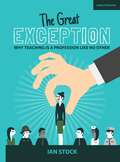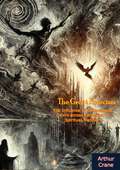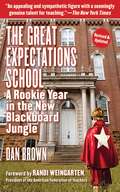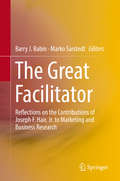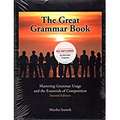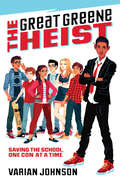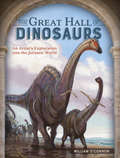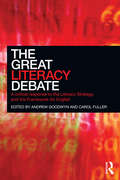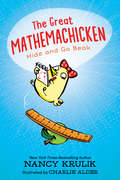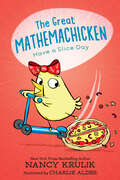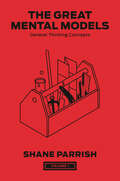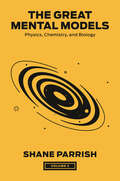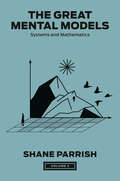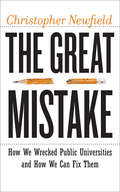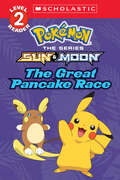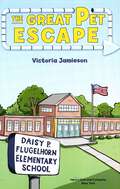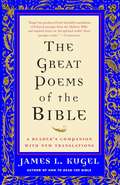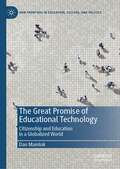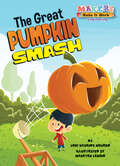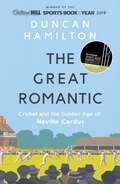- Table View
- List View
The Great Exception: Why Teaching Is A Profession Like No Other
by Ian StockTeaching is emerging from a period when attempts were made to confine and control it using industrial methods. It has become evident that this has failed either to deliver improved educational outcomes or to capture the essential nature of a teacher's work. This book by an experienced practising teacher offers an alternative interpretation of what it means to teach and proposes a perspective on the profession that represents the actual work of teachers in a fairer and more accurate way. Ian Stock's gripping new book makes an unapologetically personal examination of the problems that the approaches and policies of recent years have created for the classroom teacher. It is not afraid to tackle big issues, such as the burden of unnecessarily heavy management. It also casts doubt on the application of `big data' and purely theoretical approaches, saying that they cannot but fail to have relevance to the intimate scale at which real education functions. Instead, the book proposes a small-scale approach whereby the individual practitioner is both empowered and responsible for the development of their own best practice using a set of general principles discussed herein.
The Great Exorcism: The Influence of Demons and Devils across Centuries of Spiritual Tradition
by Arthur CraneThe Great Exorcism by Arthur Crane is an intriguing exploration of the supernatural, blending fiction, spirituality, and psychological inquiry. The narrative delves into themes of possession, inner conflict, and the eternal struggle between good and evil, creating a suspenseful and thought-provoking story centered around the process of exorcism. Crane’s work not only offers a thrilling account of a battle against dark forces but also raises questions about faith, belief, and the human psyche.At its core, The Great Exorcism follows the journey of individuals confronted with mysterious and malevolent forces beyond their control. The exorcism becomes a dramatic focal point in which physical and spiritual realms collide, placing both the possessed and the exorcists in a battle that challenges their courage, conviction, and humanity. Crane presents exorcism as not merely a ritual but a symbolic confrontation with personal fears and unresolved guilt, deepening the emotional and philosophical dimensions of the story.Through vivid descriptions and intense scenes, the narrative explores the delicate interplay between rational skepticism and spiritual faith. Characters grapple with doubts and conflicts that reflect larger societal tensions between science and religion. Crane’s storytelling skillfully weaves these elements together, creating a narrative that is as much about internal transformation as it is about supernatural confrontation.The Great Exorcism will appeal to readers who enjoy stories about the metaphysical and psychological aspects of human experience. With its blend of suspense, reflection, and spiritual exploration, the book offers more than just a dramatic tale—it invites readers to contemplate the nature of good and evil, redemption, and the enduring power of belief. Crane’s work remains a compelling read for those drawn to stories that bridge the supernatural and the human condition.
The Great Expectations School: A Rookie Year in the New Blackboard Jungle
by Dan Brown Randi WeingartenAt the age of twenty-two, Dan Brown came to P.S. 85 as an eager, fresh-faced teacher. He was even as-signed his own class: 4-217. Unbeknownst to him, 4-217 was the designated "dumping ground" for all fourth-grade problem cases, and his students would prove to be more challenging than he could have ever anticipated.Intent on being a caring, dedicated teacher but confronted with unruly children, absent parents, and a failing administration, Dan was pushed to the limit time and again: he found himself screaming with rage, punching his fist through a blackboard out of sheer frustration, often just wanting to give up and walk away. Yet, in this seeming chaos, he slowly learned-from the more seasoned teachers at the school and from his own mistakes-how to discipline, teach, and make a difference. The Great Expectations School is the touching story of Class 4-217 and their teacher, Mr. Brown. But more than that, it is the revealing story of a broken educational system and all those struggling within and fighting against it.
The Great Facilitator: Reflections on the Contributions of Joseph F. Hair, Jr. to Marketing and Business Research
by Marko Sarstedt Barry J. BabinThis commemorative volume honors the contributions of Prof. Joseph F. Hair, Jr., who through his writings, leadership and mentoring has had a profound influence on marketing and other fields of business research. He is widely known for sidestepping mathematically complex ways of teaching statistical approaches with an eye toward making the tools accessible to the average behavioral researcher. Joe is also a bona fide researcher whose work has had a massive impact on marketing and business research in general. The book provides revealing insights on his works and acknowledges his role as an outstanding teacher and mentor who has shaped generations of researchers.
The Great Gatsby SparkNotes Literature Guide (SparkNotes Literature Guide Series #30)
by SparkNotesThe Great Gatsby SparkNotes Literature Guide by F. Scott Fitzgerald Making the reading experience fun! When a paper is due, and dreaded exams loom, here's the lit-crit help students need to succeed! SparkNotes Literature Guides make studying smarter, better, and faster. They provide chapter-by-chapter analysis; explanations of key themes, motifs, and symbols; a review quiz; and essay topics. Lively and accessible, SparkNotes is perfect for late-night studying and paper writing. Includes:An A+ Essay—an actual literary essay written about the Spark-ed book—to show students how a paper should be written.16 pages devoted to writing a literary essay including: a glossary of literary termsStep-by-step tutoring on how to write a literary essayA feature on how not to plagiarize
The Great Grammar Book: Mastering Grammar Usage and the Essentials of Composition, Second Edition
by Marsha Sramek<P>This book is fun to read, with fascinating, arcane information that could make you a trivia champion.<P> The Great Grammar Book uses and explains only those grammatical terms which are necessary to avoid mistakes or improve writing skills.<P> Whether you are a student or professional, this book will help you write more effectively and clearly. <P>This book focuses on the most frequent errors in English and how to correct these errors. <P>There are enough practice sentences and exercises to overcome long-standing bad grammatical habits.
The Great Greene Heist (Arthur A Levine Novel)
by Varian JohnsonSaving the school -- one con at a time."A political heist page-turner set in middle school? Is that even possible? Varian Johnson shows us how it's done." - Gordon Korman, author of SWINDLE "Do yourself a favor and start reading immediately." - Rebecca Stead, author of WHEN YOU REACH ME Jackson Greene swears he's given up scheming. Then school bully Keith Sinclair announces he's running for Student Council president, against Jackson's former friend Gaby de la Cruz. Gaby wants Jackson to stay out of it -- but he knows Keith has "connections" to the principal, which could win him the presidency no matter the vote count. So Jackson assembles a crack team: Hashemi Larijani, tech genius. Victor Cho, bankroll. Megan Feldman, science goddess. Charlie de la Cruz, reporter. Together they devise a plan that will take down Keith, win Gaby's respect, and make sure the election is done right. If they can pull it off, it will be remembered as the school's greatest con ever -- one worthy of the name THE GREAT GREENE HEIST.
The Great Hall of Dinosaurs: An Artist's Exploration into the Jurassic World
by William O'ConnorScience and Imagination Collide!The Great Hall of Dinosaurs is an illustrated guide to studying and drawing dinosaurs from the best-selling author of the Dracopedia series! Astounding dioramas of the world's biggest, fiercest and fastest creatures line the halls, from a lumbering family of grazing triceratops and a gnashing T-rex to a duo of swift-footed carnotaurs. History's "terrible lizards" are more than a thundering Hollywood nightmare. William O'Connor brings these beautiful and complex beasts to life through accurate illustration based on the anatomical and scientific knowledge of contemporary paleontology. But in The Great Hall of Dinosaurs, our imaginations are not limited by science: We can dream of worlds and scenes that may have existed millions of years ago, of animals we have never seen before, using nothing more than a simple no. 2 pencil and some paper.Learn the basics of scene setting. Create believable natural dioramas with depth, dinosaurs and detailed Mesozoic ecosystems in which your creatures could live and hunt, such as mountains, forests, deserts and seashores.16 complete step-by-step demonstrations. Build your drawings from initial composition and thumbnail sketching to completed piece through color concepting, underpainting, texture development and more with both digital and traditional painting techniques.Master dino morphology. Each demonstration offers a description, history, biological diagram and skeletal composition of the most popular dinosaurs, including personality traits, diet and dates of fossil discovery.Glossary of prehistoric terms.
The Great Literacy Debate: A Critical Response to the Literacy Strategy and the Framework for English
by Andrew Goodwyn Carol FullerThe nature of literacy is an issue of global debate. When the National Literacy Strategy [NLS] was introduced into UK schools it was arguably the most ambitious educational reform programme in the world, and the controversy necessarily intensified. How can the impact of such reforms be assessed? In its ten year history the NLS affected every primary and secondary teacher in the country and, therefore, every child. The initiative provoked a widespread recognition of the importance of literacy for all children and attracted the attention of many other governments. This book is the first definitive and objective review and evaluation of the impact of these literacy reforms. With contributions from the most respected experts on literacy and English from the UK and from across the world, this unprecedented critical examination explores: How teaching policy and practice were impacted by the reforms How the NLS came into being, how it was operated, what it did and did not achieve What we can learn from its successes and failures The most important aspects of the reforms, from policing grammar to the impact of ‘The Literacy Game’ and ‘informed prescription’ on teaching. Whether you are a policy maker or classroom teacher, this book is an invaluable resource to anyone concerned about literacy. It provides readers from around the world with a genuine and evidence-based perspective on this immense initiative, lucidly evaluating the lessons learned from both its ambitions and its failures.
The Great Mathemachicken 1: Hide and Go Beak (The Great Mathemachicken)
by Nancy KrulikA new young chapter book series about a chicken who loves math, science, and learning new things--by New York Times bestselling author Nancy Krulik for fans of Unlimited Squirrel and Bumble and Bee.Chirpy is a young chicken stuck in the family coop. But she's not like the other chickens who just sit around peck peck pecking all day. She's intrigued by the children who come home from a place called school. They always look so happy! (Well, most days.) So Chirpy sneaks onto the bus one morning, hides in the classroom . . . and discovers a true love of math. When she shares what she's learned with the other chickens, they think she's one kernel short of a cob. Even so, Chirpy is determined to find a formula for fowl success by pecking away. But when a hungry fox tries to attack the coop, can she find the equation for a simple solution? With lively two-color art throughout and a fun hands-on simple machine activity, this eggs-ellent hilarious young chapter book series starter is a Grade-A pick for emerging readers to get them eggs-ited about science and math.
The Great Mathemachicken 2: Have a Slice Day (The Great Mathemachicken #2)
by Nancy KrulikChirpy the chick makes a new friend who helps her discover how delicious fractions can be in the second book in New York Times bestselling author Nancy Krulik.After her feats of math and science derring-do, Chirpy is the talk of the coop. So when the chicks face a new problem—Clucky greedily chomping down on all the chow—they turn to their Great Mathemachicken for a solution.Wandering off to think, she meets Quackers, a very curious duck, who has a lot of his own questions. Unfortunately, Chirpy doesn&’t have answers. But she knows the best place to find them—school! So the pair hops on the bus to do some investigation, learning about reading and pizza, tally marks and fractions. And it turns out, fractions are yummy . . . and may be the answer to the chickens&’ coop conundrum.The second book in the Great Mathemachicken chapter book series, combines New York Times bestselling author Nancy Krulik&’s trademark humor and clever wordplay with hilarious and lively two-color artwork from the incredibly talented Charlie Alder, to create an engrossing and charming STEM-based adventure that will have young readers clucking for more.
The Great Mathemachicken 3: Sing High, Sing Crow (The Great Mathemachicken #3)
by Nancy KrulikChirpy the chick learns that music is math, and songs can solve noisy problems in the third book in the Great Mathemachicken series, written by New York Times bestselling author Nancy Krulik and illustrated by Charlie Alder.Chirpy the chicken is not feeling very chipper when a group of birds calling themselves the Crow Family Band keeps the coop awake with their loud singing. She&’s supposed to be the Great Mathemachicken, but math can&’t solve their sleep problems. Or can it? At school, Chirpy and Quackers are singing a new tune as they take a trip to the music classroom. There, they learn about musical notes, which seem to work an awful lot like fractions. And when she sees how Mrs. Zoober&’s students, singing high and low, together make one wonderful tune, she gets a egg-stra good idea how the chickens might join forces . . . and even add some feathered new friends to the mix, to make something truly special.The third book in the Great Mathemachicken chapter book series, combines New York Times bestselling author Nancy Krulik&’s trademark humor and clever wordplay with hilarious and lively two-color artwork from the incredibly talented Charlie Alder, to create an engrossing and charming STEAM-based adventure that will have young readers clucking for more.
The Great Mental Models, Volume 1: General Thinking Concepts (The Great Mental Models Series #1)
by Shane Parrish Rhiannon BeaubienDiscover the essential thinking tools you&’ve been missing with The Great Mental Models series by Shane Parrish, New York Times bestselling author and the mind behind the acclaimed Farnam Street blog and &“The Knowledge Project&” podcast.This first book in the series is your guide to learning the crucial thinking tools nobody ever taught you. Time and time again, great thinkers such as Charlie Munger and Warren Buffett have credited their success to mental models–representations of how something works that can scale onto other fields. Mastering a small number of mental models enables you to rapidly grasp new information, identify patterns others miss, and avoid the common mistakes that hold people back.The Great Mental Models: Volume 1, General Thinking Concepts shows you how making a few tiny changes in the way you think can deliver big results.Drawing on examples from history, business, art, and science, this book details nine of the most versatile, all-purpose mental models you can use right away to improve your decision making and productivity.This book will teach you how to:Avoid blind spots when looking at problems.Find non-obvious solutions. Anticipate and achieve desired outcomes. Play to your strengths, avoid your weaknesses, … and more.The Great Mental Models series demystifies once elusive concepts and illuminates rich knowledge that traditional education overlooks. This series is the most comprehensive and accessible guide on using mental models to better understand our world, solve problems, and gain an advantage.
The Great Mental Models, Volume 2: Physics, Chemistry, and Biology (The Great Mental Models Series #2)
by Shane Parrish Rhiannon BeaubienFrom the New York Times bestselling author of Clear Thinking and Farnam Street founder, Shane Parrish. The second book in the timeless Great Mental Models series.Time and time again, great thinkers such as Charlie Munger and Warren Buffett have credited their success to mental models–representations of how something works that can scale onto other fields.Mastering a small number of mental models enables you to rapidly grasp new information, identify patterns others miss, and avoid the common mistakes that hold people back.Volume 2 of The Great Mental Models series provides a collection of over twenty important concepts from physics, chemistry, and biology in a clear and accessible style. Not only will you better understand the hidden forces that influence the world around you, you&’ll also learn how those forces can work to your advantage.Some of the mental models covered in this book include:Leverage: When the application of a small force to one end results in a larger force at the other end.Inertia: An object (or organization) at rest will stay at rest unless acted upon by an external force.Activation Energy: The minimum amount of energy required to incite a chemical reaction.Ecosystems: A community of organisms that have complex relationships to each other.The Great Mental Models series demystifies once elusive concepts and illuminates rich knowledge that traditional education overlooks. This series is the most comprehensive and accessible guide on using mental models to better understand our world, solve problems, and gain an advantage.
The Great Mental Models, Volume 3: Systems and Mathematics (The Great Mental Models Series #3)
by Shane Parrish Rhiannon Beaubien Rosie LeizrowiceFrom the New York Times bestselling author of Clear Thinking and Farnam Street founder, Shane Parrish. The third book in the timeless Great Mental Models series.Time and time again, great thinkers such as Charlie Munger and Warren Buffett have credited their success to mental models–representations of how something works that can scale onto other fields.Mastering a small number of mental models enables you to rapidly grasp new information, identify patterns others miss, and avoid the common mistakes that hold people back.Volume 3 of The Great Mental Models series focuses on systems and mathematics, simplifying more than twenty-four key concepts from these technical fields into easy-to-understand terms. It provides insights into the unseen mechanisms that influence our environment and teaches you how to apply these principles to benefit your life.Some of the mental models covered in this book include:Margin of Safety: Engineers design for extremes, not averages. To create a robust system, ensure a meaningful gap between what the system is capable of handling and what it is required to handle.Compounding: The most powerful force in the universe can work in domains other than money.The law of diminishing returns: Inputs to a system lead to more output, up until a point where each further unit of input will lead to a decreasing amount of output.Regression to the mean: Above- or below- average performance tends to correct towards the average over the long term.The Great Mental Models series demystifies once elusive concepts and illuminates rich knowledge that traditional education overlooks. This series is the most comprehensive and accessible guide on using mental models to better understand our world, solve problems, and gain an advantage.
The Great Mental Models, Volume 4: Economics and Art (The Great Mental Models Series #4)
by Shane Parrish Rhiannon BeaubienFrom the New York Times bestselling author of Clear Thinking and Farnam Street founder, Shane Parrish. The fourth and final installment in the timeless Great Mental Models series.Time and time again, great thinkers such as Charlie Munger and Warren Buffett have credited their success to mental models–representations of how something works that can scale onto other fields.Mastering a small number of mental models enables you to rapidly grasp new information, identify patterns others miss, and avoid the common mistakes that hold people back.Volume 4 of The Great Mental Models series delves into the realms of economics and art, presenting more than twenty-four valuable ideas with clear language and style. This book equips you with an understanding of the dynamics shaping our world. It will teach you strategies to leverage these principles and give you a significant edge in the aspects of life you value most.Some of the mental models covered in this book include: Creative destruction: New innovations must sometimes come at the cost of maintaining the status quo.Representation: The depiction of an idea can be visual, but it can also rely on symbols or other ideas.Genre: Creative expressions tend to be grouped according to socially constructed norms; while a work can play with or bend genre, it can&’t exist outside of genre.The Great Mental Models series demystifies once elusive concepts and illuminates rich knowledge that traditional education overlooks. This series is the most comprehensive and accessible guide on using mental models to better understand our world, solve problems, and gain an advantage.
The Great Mistake: How We Wrecked Public Universities and How We Can Fix Them (Critical University Studies)
by Christopher NewfieldA remarkable indictment of how misguided business policies have undermined the American higher education system.Winner of the CHOICE Outstanding Academic Title of the Choice ACRLHigher education in America, still thought to be the world leader, is in crisis. University students are falling behind their international peers in attainment, while suffering from unprecedented student debt. For over a decade, the realm of American higher education has been wracked with self-doubt and mutual recrimination, with no clear solutions on the horizon. How did this happen? In this stunning new book, Christopher Newfield offers readers an in-depth analysis of the "great mistake" that led to the cycle of decline and dissolution, a mistake that impacts every public college and university in America. What might occur, he asserts, is no less than locked-in economic inequality and the fall of the middle class. In The Great Mistake, Newfield asks how we can fix higher education, given the damage done by private-sector models. The current accepted wisdom—that to succeed, universities should be more like businesses—is dead wrong. Newfield combines firsthand experience with expert analysis to show that private funding and private-sector methods cannot replace public funding or improve efficiency, arguing that business-minded practices have increased costs and gravely damaged the university’s value to society. It is imperative that universities move beyond the destructive policies that have led them to destabilize their finances, raise tuition, overbuild facilities, create a national student debt crisis, and lower educational quality. Laying out an interconnected cycle of mistakes, from subsidizing the private sector to "the poor get poorer" funding policies, Newfield clearly demonstrates how decisions made in government, in the corporate world, and at colleges themselves contribute to the dismantling of once-great public higher education. A powerful, hopeful critique of the unnecessary death spiral of higher education, The Great Mistake is essential reading for those who wonder why students have been paying more to get less and for everyone who cares about the role the higher education system plays in improving the lives of average Americans.
The Great Pancake Race (Scholastic Reader, Level 2)
by Jeanette LaneRead all about your favorite Pokémon in this Scholastic Level 2 Reader. It's designed just for kids mastering their phonics and readingAsh and Pikachu want to win the Pokémon Pancake Race. Can they beat last year’s champ, Alolan Raichu? The leader of the pack wins a big stack— free pancakes for a year!This easy-to-read book is based on an exciting episode from the Pokémon animated TV series.
The Great Pet Escape (Pets On The Loose!)
by Victoria Jamieson“A young graphic novel chapter book about the escape escapades of class pets at Daisy P. Flugelhorn Elementary School.”
The Great Poems of the Bible: A Reader's Companion with New Translations
by James L. KugelFrom the Psalms to the Prophets, from job to Ecclesiastes, much of the Bible is written in poetry. The poems of the Bible include some of its best known and most beloved passages: "The Lord is my shepherd," "Let justice roll down like waters," "By the rivers of Babylon," "Remember your Creator," "Arise, shine, for thy light is come!" These poems live in the hearts of those who are familiar with the Bible and offer rich rewards to anyone who is approaching the world's greatest book for the first time.In The Great Poems of the Bible, Harvard scholar James Kugel presents original translations of the most beautiful and important poems of the Scripture. Taken together, these poems represent the very essence of the Hebrew Bible. Reading them one after another is like taking a guided tour through Scripture, meeting firsthand some of its most important teachings and opening the way to an understanding of the Bible as a whole.Each poem is accompanied by an eloquent and accessible explanation of the poem's language, and a reflection on its meaning. These learned, compact essays introduce readers to the broader spiritual world of ancient Israel. What did people in biblical times believe about God? Where is a person's soul located and what does it do? Is there an afterlife? How does one come to "know" God? Why wasn't Eve meant to be Adam's "helpmate" (Kugel shows how this was just a translator's slip-up), and what does the Bible have to say about the role of women?Kugel's sparkling translations of the poems, together with the fascinating insights that accompany them, distill the very best that the Bible and modern scholarship have to offer. Kugel brings new life to some of history's greatest poems, and offers a new look at a Bible we thought we already knew. Here, in one volume, is a "Bible's bible" that belongs in every home.
The Great Promise of Educational Technology: Citizenship and Education in a Globalized World (New Frontiers in Education, Culture, and Politics)
by Dan MamlokThis book critically looks at the tensions between the promise to transform education through the use of digital technology and the tendency to utilize digital technology in instrumental and technical ways. The widespread use of digital technology has had a remarkable effect on almost every domain of human life. This technological change has caused governments, educational departments, and non-governmental organizations (NGOs) to recognize the need to develop educational plans that would support the social and the cultural changes that have occurred with the ubiquitous permeation of digital technology into our everyday lives. This book challenges common assumptions regarding digital technology and education, through critical exploration of educational policies, interviews, and class observations in the US and Israel. In doing so, the author sheds light on the possibilities of advancing digital citizenship under current educational policies.
The Great Pumpkin Smash (Makers Make It Work)
by Lori Haskins HouranFor Luke, autumn in Florida feels weird. There are no changing leaves, no cider, and worst of all, no pumpkin chucking! But maybe he can engineer a way to bring pumpkin spice to the south. Tying into the popular Makers Movement, Makers Make It Work is a series of fun easy-to-read stories that focus on problem-solving and hands-on action. This charming story explores the Makers theme of Engineering and includes explanatory sidebars and a catapult activity for young makers to try themselves!
The Great Romantic: Cricket and the golden age of Neville Cardus
by Duncan HamiltonNeville Cardus described how one majestic stroke-maker 'made music' and 'spread beauty' with his bat. Between two world wars, he became the laureate of cricket by doing the same with words.In The Great Romantic, award-winning author Duncan Hamilton demonstrates how Cardus changed sports journalism for ever. While popularising cricket - while appealing, in Cardus' words to people who 'didn't know a leg-break from the pavilion cat at Lord's'- he became a star in his own right with exquisite phrase-making, disdain for statistics and a penchant for literary and musical allusions. Among those who venerated Cardus were PG Wodehouse, John Arlott, Harold Pinter, JB Priestley and Don Bradman. However, behind the rhapsody in blue skies, green grass and colourful characters, this richly evocative biography finds that Cardus' mother was a prostitute, he never knew his father and he received negligible education. Infatuations with younger women ran parallel to a decidedly unromantic marriage. And, astonishingly, the supreme stylist's aversion to factual accuracy led to his reporting on matches he never attended. Yet Cardus also belied his impoverished origins to prosper in a second class-conscious profession, becoming a music critic of international renown. The Great Romantic uncovers the dark enigma within a golden age.
The Great Romantic: Cricket and the golden age of Neville Cardus - Winner of the William Hill Sports Book of the Year
by Duncan HamiltonNeville Cardus described how one majestic stroke-maker 'made music' and 'spread beauty' with his bat. Between two world wars, he became the laureate of cricket by doing the same with words.In The Great Romantic, award-winning author Duncan Hamilton demonstrates how Cardus changed sports journalism for ever. While popularising cricket - while appealing, in Cardus' words to people who 'didn't know a leg-break from the pavilion cat at Lord's'- he became a star in his own right with exquisite phrase-making, disdain for statistics and a penchant for literary and musical allusions. Among those who venerated Cardus were PG Wodehouse, John Arlott, Harold Pinter, JB Priestley and Don Bradman. However, behind the rhapsody in blue skies, green grass and colourful characters, this richly evocative biography finds that Cardus' mother was a prostitute, he never knew his father and he received negligible education. Infatuations with younger women ran parallel to a decidedly unromantic marriage. And, astonishingly, the supreme stylist's aversion to factual accuracy led to his reporting on matches he never attended. Yet Cardus also belied his impoverished origins to prosper in a second class-conscious profession, becoming a music critic of international renown. The Great Romantic uncovers the dark enigma within a golden age.
The Great Romantic: Cricket and the golden age of Neville Cardus - Winner of the William Hill Sports Book of the Year
by Duncan HamiltonNeville Cardus described how one majestic stroke-maker 'made music' and 'spread beauty' with his bat. Between two world wars, he became the laureate of cricket by doing the same with words.In The Great Romantic, award-winning author Duncan Hamilton demonstrates how Cardus changed sports journalism for ever. While popularising cricket - while appealing, in Cardus' words to people who 'didn't know a leg-break from the pavilion cat at Lord's'- he became a star in his own right with exquisite phrase-making, disdain for statistics and a penchant for literary and musical allusions. Among those who venerated Cardus were PG Wodehouse, John Arlott, Harold Pinter, JB Priestley and Don Bradman. However, behind the rhapsody in blue skies, green grass and colourful characters, this richly evocative biography finds that Cardus' mother was a prostitute, he never knew his father and he received negligible education. Infatuations with younger women ran parallel to a decidedly unromantic marriage. And, astonishingly, the supreme stylist's aversion to factual accuracy led to his reporting on matches he never attended. Yet Cardus also belied his impoverished origins to prosper in a second class-conscious profession, becoming a music critic of international renown. The Great Romantic uncovers the dark enigma within a golden age.
